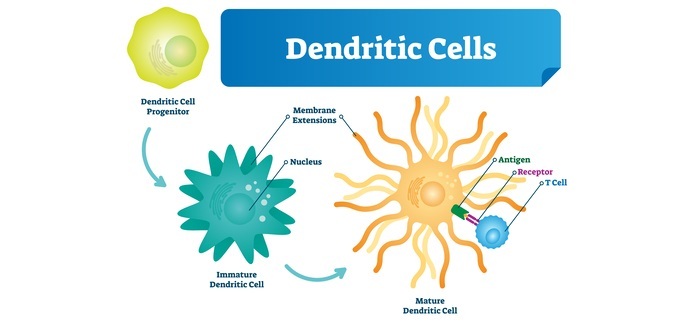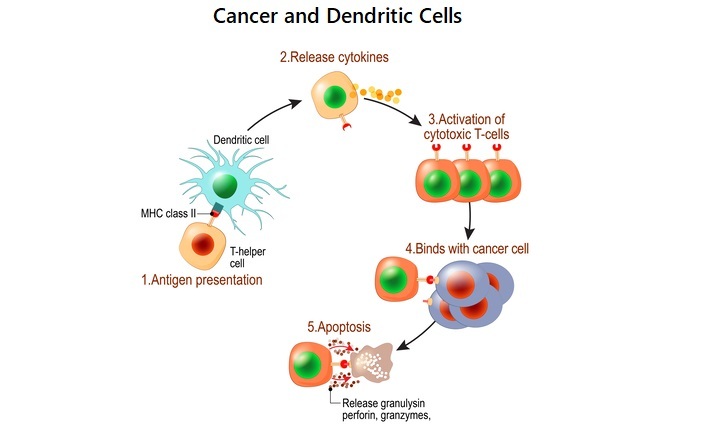
 Data Structure
Data Structure Networking
Networking RDBMS
RDBMS Operating System
Operating System Java
Java MS Excel
MS Excel iOS
iOS HTML
HTML CSS
CSS Android
Android Python
Python C Programming
C Programming C++
C++ C#
C# MongoDB
MongoDB MySQL
MySQL Javascript
Javascript PHP
PHPPhysics
Chemistry
Biology
Mathematics
English
Economics
Psychology
Social Studies
Fashion Studies
Legal Studies
- Selected Reading
- UPSC IAS Exams Notes
- Developer's Best Practices
- Questions and Answers
- Effective Resume Writing
- HR Interview Questions
- Computer Glossary
- Who is Who
Life Cycle of Dendritic Cells: Types and Disease
Introduction
Dendritic cells (DCs) are a type of immune cell that play a critical role in the immune system. They are responsible for identifying, capturing, processing, and presenting antigens to T cells.
DCs are found in most tissues of the body, including lymphoid and non-lymphoid tissues, and are critical for the initiation and regulation of immune responses. This tutorial will explore the life cycle of dendritic cells, their different types, and their role in various diseases.

Dendritic Cell Presenting Antigen to T-Cell
Life Cycle of Dendritic Cells
Dendritic cells are derived from hematopoietic stem cells in the bone marrow. Once they are generated, they circulate in the bloodstream and migrate to various tissues. When they reach a tissue, they differentiate into immature dendritic cells (iDCs).
These cells are characterized by their long, branching projections called dendrites, which are used to capture and process antigens. iDCs are activated when they encounter antigens, which can be derived from pathogens, tumor cells, or self-antigens. Once activated, iDCs undergo a process called maturation, which involves changes in their morphology, gene expression, and function.
Mature dendritic cells (mDCs) are highly efficient at antigen presentation and are capable of stimulating T cell responses. After presenting antigens to T cells, mDCs undergo apoptosis, or programmed cell death. This process is essential for preventing excessive immune responses and maintaining immune tolerance.
However, some mDCs can also differentiate into long-lived DCs, which can persist in tissues for extended periods and contribute to immune memory.

Types of Dendritic Cells
Dendritic cells are a heterogeneous population of cells that can be divided into several subtypes based on their phenotype, function, and location. These include -
Conventional DCs
Conventional dendritic cells (cDCs) are the most well-characterized DC subtype and are found in lymphoid and non-lymphoid tissues. They are classified into two major subtypes: cDC1 and cDC2.
cDC1s are characterized by their expression of the transcription factor Batf3 and the surface markers CD8α and XCR1. They are specialized in cross-presentation of antigens, which is the ability to present exogenous antigens on MHC class I molecules to CD8+ T cells. cDC1s are critical for the induction of cytotoxic T cell responses against viruses and tumors.
cDC2s express the transcription factor IRF4 and the surface markers CD11b and CD172a. They are more efficient at presenting antigens on MHC class II molecules to CD4+ T cells and are essential for the activation of helper T cell responses. cDC2s are also involved in the induction of regulatory T cells, which are critical for maintaining immune tolerance.
Plasmacytoid DCs
Plasmacytoid dendritic cells (pDCs) are another subtype of DCs that are primarily found in lymphoid tissues. They are characterized by their expression of the transcription factor IRF7 and the surface markers CD123 and BDCA-2. pDCs are specialized in the production of type I interferons in response to viral infections and are critical for antiviral immunity.
Langerhans Cells
Langerhans cells (LCs) are a specialized DC subtype that is found in the skin. They are characterized by their expression of the surface marker CD1a and the presence of Birbeck granules, which are tennis racket-shaped organelles. LCs are involved in the induction of immune responses against skin pathogens and are also involved in the induction of skin tolerance.
Diseases Associated with Dendritic Cells
Dendritic cells play a critical role in the immune system and as such, dysfunction of these cells can lead to various diseases. Here are some diseases associated with dendritic cells −
Cancer
Dendritic cells play a crucial role in the immune response against cancer. They are responsible for presenting tumor antigens to T cells and inducing cytotoxic T cell responses.

However, tumors can evade immune surveillance by impairing dendritic cell function. For example, tumors can secrete immunosuppressive factors that inhibit dendritic cell maturation and antigen presentation, or they can induce the accumulation of regulatory T cells that suppress the immune response.
Autoimmune Diseases
Autoimmune diseases are characterized by the immune system attacking the body's own tissues. Dendritic cells play a critical role in the induction and regulation of autoimmune responses. For example, in type 1 diabetes, dendritic cells present pancreatic islet antigens to autoreactive T cells, leading to destruction of insulin-producing cells. In multiple sclerosis, dendritic cells present myelin antigens to autoreactive T cells, leading to demyelination of the nervous system.
Infectious Diseases
Dendritic cells are essential for the initiation and regulation of immune responses against pathogens. However, some pathogens can manipulate dendritic cell function to evade immune surveillance. For example, HIV can infect and replicate in dendritic cells, impairing their function and leading to immune suppression. Mycobacterium tuberculosis can also manipulate dendritic cell function to promote bacterial survival and dissemination.
What Do We Know
Dendritic cells are a critical component of the immune system and play a crucial role in the initiation and regulation of immune responses. They are a heterogeneous population of cells that can be divided into several subtypes based on their phenotype, function, and location.
Dysfunction of dendritic cells can lead to various diseases, including cancer, autoimmune diseases, and infectious diseases. Understanding the life cycle and function of dendritic cells is critical for the development of new therapies and interventions for these diseases.

